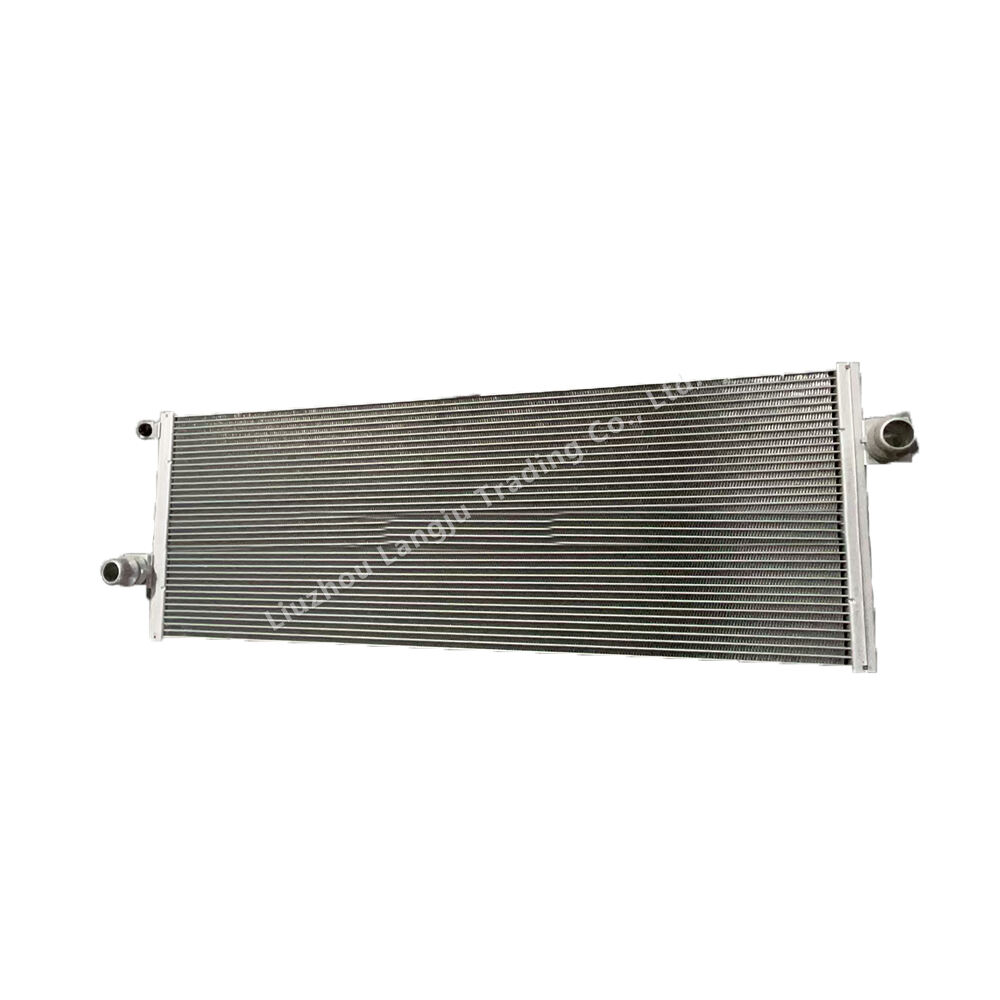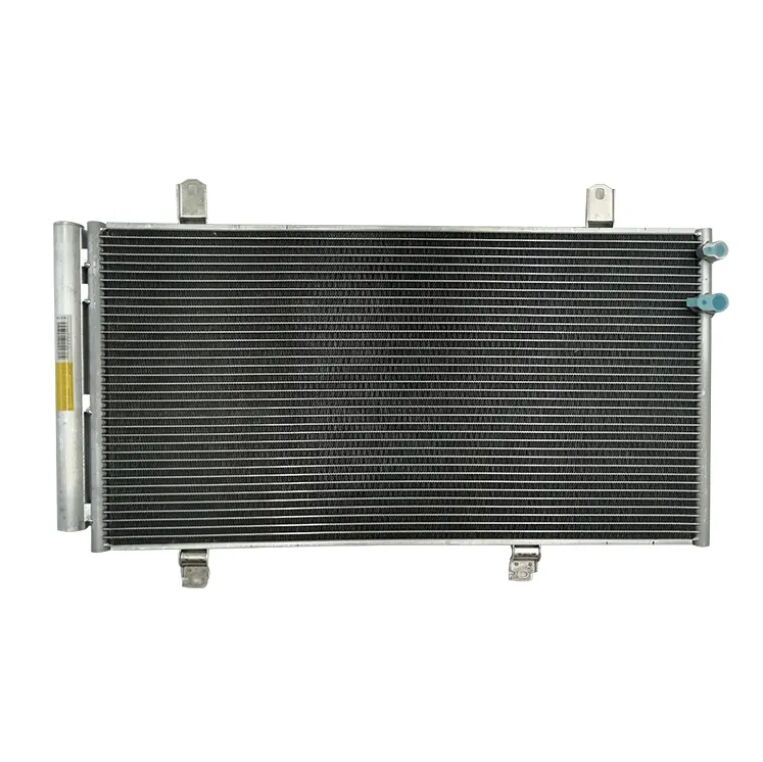רדיטורים של נחושת: תדמית מרבית עם דרישות תחזוקה
יכולת העברה של חום בלתי מובחנת
רדיאטורים נחושת בולטות כי הם להעביר חום כל כך טוב בזכות כמה הם מוליכים חום. הם פשוט סופגים ומפיצים חום טוב יותר בהשוואה למה שאנחנו רואים עם דגמי אלומיניום בשוק היום. מחקרים מראים כי נחושת יכולה למעשה לשחרר חום ב-30% מהר יותר מאשר גרסאות אלומיניום, דבר שחשוב מאוד בעת בניית מכוניות שזקוקות לכוח הקירור המקסימלי בתנאי מתח. תנועת חום טובה מונעת ממנועים להתחמם יותר מדי, שומרת על כל דבר פועל בצורה חלקה ומארכת את זמן חיי המכונות האלה לפני שהם צריכים תיקונים. מכונאים ובונים מכוניות לעתים קרובות הולכים עבור אופציות נחושת בכל פעם ביצועים תרמיים באמת חשובים, במיוחד במרוצים או יישומים כבדים שבו בקרת טמפרטורה עושה את כל ההבדל בין הצלחה לכישלון.
פגיעות קורוזיה ברכבים מודרניים
רדיאטורים נחושת פועלים מצוין להעברת חום, אך הם נוטים להתנוון עם הזמן, במיוחד כאשר הם נחשפים לחות או לאוויר מלחתי בקרבת אזורי חוף. הבעיה מחריפה עוד יותר מכיוון שרוב מערכות הקירור ברכב מערבבות סוגים שונים של מתכות, מה שיוצר את מה שמכנים בתהליך קורוזיה גלוונית. תהליך כימי איטי זה פוגע במרכיבי הנחושת עד שלבסוף משהו נכשל. בדיקות תחזוקה שגרתיות הן מאוד חשובות כאן. מומלץ על ידי מיכאנים להטיח סпре אנטי-קורוזיה מיוחד במהלך תחזוקה רגילה ולבחון את ליבת הרadiator בקפידה כדי לאתר סימני פגיעה מוקדמים. רבים מהנהגים מגלים שהשקעה נוספת בתקופת תחזוקה איכותית חוסכת כסף לאורך זמן, מכיוון שרדיאטורים נחושת נמשכים הרבה יותר כשהם מוגנים כראוי. למרות שנחושת מציעה תכונות תרמיות ausgezeichnetות, הרגישות שלה לפירוק הופכת אותה למין איזון בין ביצועים טובים ברגע זה לבין עלויות ההחלפה בעתיד.
השפעה כבדה על יעילות הדלק
רדיאטורים נחושת שוקלים יותר בהשוואה לאלו שמיוצרים מאלומיניום, מה שיכול להוות בעיה אמיתית מבחינת יעילות הדלק - במיוחד במכוניות קומפקטיות, בהן כל אונקיה נחשבת. מחקר מצביע על כך שמשקל נוסף ברכב מפחית את צריכת הדלק בטווח של 1% עד 2%. לכן קיים מאבק מתמיד בין היכולת הטובה יותר לפלט חום של הנחושת לבין הירידה ביעילות הדלק שנובעת מהמשקל הגבוה. כשיצרני רכב שוקלים האם להשתמש בנוشت או להמשיך עם אלומיניום, הם בעצם מתקדמים על חבל דק בין היעילות של מעבר החום מצד אחד, לבין יעילות הדלק כאשר הרכב כבד יותר. רוב המהנדסים האוטומotive בוזלים זמן רב בחישובים הקשורים לבעיה זו כחלק מהתהליך העיצוב של דגמים חדשים.
מקררים אלומיניום: ביצועים מאוזנים עבור רכבים מודרניים
יתרון קלילות ואנטי-קורוזיה
רדיאטורים אלומיניום מקבלים הרבה שבחים כי הם הרבה יותר קלים מאשר אלה נחושת. אנחנו מדברים על בערך חצי משקל, מה שעושה הבדל אמיתי כשמדובר בהישג דלק טוב יותר. המשקל המופחת עושה יותר מאשר לחסוך דלק. מכוניות גם מסתובבות טוב יותר, והביצועים הכוללים מקבלים גידול ניכר. יתר גדול נוסף הוא איך רדיאטורים אלה עמידים היטב חלודה וזיהום. הם יכולים לקחת כל מה שאמא טבע זורקת אליהם מהאוויר המלוח של החוף עד לחלקים של הרים. זה אומר פחות נסיעות למכונאי לתקנות או להחליפות. כל תעשיית הרכב מתקדמת לאחרונה לכיוון בניית כלי רכב קלים יותר, ורדיאטורים אלומיניום מתאימים היטב לאסטרטגיה זו. מכוניות קלות יותר אומרנה ניהול טוב יותר סביב פינות וכל אלה חסכונות דלק חשובים במשאבה.
תהליך ייצור חסכוני
ייצור רדיאטורים מאלומיניום במקום רדיאטורים מעורף חוסך כסף לכל הצדדים, מה שאומר ש막ורות invesט פחות ולקוחות שולמים פחות. אלומיניום מצוי בשפע בימינו, ולכן הוא לא עולה כמו מתכות נדירות כמו נחושת. זו אחת הסיבות למהנדסי רכב אוהבים לעבוד עם אלומיניום כל כך. שיפורים אחרונים בטכניקות עיבוד אלומיניום הביאו לכך שיהיה קל יותר לעצב ולשכן אותו, מה שמוריד את העלות אפילו יותר ומסביר למה כל כך הרבה רכבים יוצאים היום עם חלקים מאלומיניום. עם חומרים זולים יותר וזמנים של ייצור מהירים יותר, גם החברות ש contruct את הרכבים וגם האנשים שקונים אותם יכולים לחסוך כסף אמיתי.
השוואת יעילות תרמית עם נחושת
אלומיניום אינו מוליך חום כמו נחושת, אך עיצובים חדשים של רדיאטורים סגרו את הפער במידה רבה. יצרנים ניסו צורות משופרות של שיניים וסידורי צינורות שמשפרים את תנועת האוויר במערכת ומעבירים את החום מהמנוע. בדיקות בשטח מציגות שהיחידות הללו מאלומיניום מסירות חום באופן שווה אפקטיבי כמו הנחושת במרבית המצבים. בתנאי נהיגה רגילים, אלומיניום הוא בחירה מתקבלת על הדעת כיוון שהוא קליל יותר. אך כאשר מדובר במכוניות מרוץ או משאיות כבדות שמייצרות כמויות עצומות של חום, רבים מהמנוענים עדיין מעדיפים רדיאטורים מנחושת שכן הם מטפלים בטמפרטורות קיצוניות בצורה טובה בהרבה. הבחירה בסופו של דבר תלויה בסוג הלחץ אותו מערכת הקירור תעמוד בפניה מיום ליום.
רדיאטורים מסיב-פלסטיק: חדשנות קלה במשקל
יתרונות הפחתת המשקל
רדיאטורים מרוכבי פלסטיק חוסכים הרבה במשקל, דבר שיצרני רכב תופסים כשחשוב לשיפור יעילות הדלק. כשמערכת הקירור נעשית קלה יותר, המנוע אינו צריך לעבוד קשה כפי שפעם, ולכן המכוניות מסיימות עם תצרוכת דלק טובה יותר בכביש. בנוסף, המעבר לחלקים פלסטיים עוזר בהפחתת פליטת הפחמן מהכלי רכב, מה שמתאים למגמה בה יצרני רכב מכוונים כיום בפתרונות הירוקים שלהם. חברות רבות כבר החלו לעבור לאופציה הזו לא רק בגלל שהרגולציה מחייבת, אלא גם בגלל שצרכנים מעוניינים להזמין לחנייה שלהם אפשרויות ידידותיות לסביבה.
מגבלות סובלנות חום לאורך זמן
חומרי קומפוזיט פלסטיים נתקלים לרוב בקושי בלעמוד בטמפרטורות גבוהות לעומת מברזמים מתכתיים קלאסיים, וזה משפיע על משך השירות שלהם לפני שהצורך בהחלפה או תיקון מתעורר. כאשר חומרים אלו נחשפים לטמפרטורות גבוהות במיוחד לתקופות ממושכות, הם מתחילים להתפרק מבפנים החוצה. משמעות הדבר היא שמנועים נאלצים לבדוק אותם בתדירות גבוהה יותר, ולעיתים להחליף חלקיים לחלוטין לאחר כמה שנים של שימוש. עם זאת, חוקרים אינן יושבים על הידיים. מעבדות ברחבי המדינה עסוקות בפיתוח נוסחאות חדשות לקומפוזיטים שיעמדו בטמפרטורות גבוהות טוב יותר מבלי לאבד את שלמותם המבנית. חלק מהתבניות כבר הראו תוצאות מבשרות שalom בטיחות בטמפרטורות שמספיקות להמיס קומפוזיטים פלסטיים רגילים תוך מספר שעות.
עיצובמיזמים היברידיים עם חלקי מתכת
יצרנים התחילו לערבב חלקים מתכתיים לתוך רדיאטורים מרכב פלסטי מכיוון שגרסאות פלסטיק טהורות פשוט אינן מספקות בحالים מסוימים. הגישה ההיברידית החדשה מנצלת את היתרונות של הפלסטיק (קלות) וכן את היתרונות של מעבר החום שמספקים המתכות. שילוב זה יוצר רדיאטורים שמבצעים טוב יותר באופן כללי מבלי להתפשר יתרה על המשקל. יצרני רכב אוהבים במיוחד את זה מכיוון שהם צריכים מערכות קירור שלא יוסיפו נפח מיותר אך עדיין יבצעו באופן מהימן תחת לחץ. עם סטנדרטים חומרי דלק הולכים ומחמירים, והולכת וצומחת נוכחות כלי התחבורה החשמליים, שיפורים מסוג זה ברדיאטורים הופכים לנפוצים בתעשייה, כאשר חברות מנסות להישאר תחרותיות מבלי להתפשר על איכות או ביטחון.
השוואה ביצועים של חומרים
שיטות התפזרות חום בין חומרים
כשמביטים ביכולת של חומרים שונים להתמודד עם אובדן חום, נחושת מוכיחה את עליונותה בהשוואה לאלומיניום ולأنواع הפלסטיק. היכולת של הנחושת להוליך חום היא פשוט מרשימה, מה גם שהיא עובדת מצוין בסיטואציות של הספק גבוה, בהן חשוב מאוד להיפטר מהחום במהירות. אלומיניום אינו טוב כמו נחושת, אך גם הוא מבצע עבודה סבירה, במיוחד כשמעוצבים מערכות специально למכוניות ממוצעות ולא למכוניות ספורט. בכל זאת, התאמה בין תכונות החומר למאפייני המכונית היא הכרחית לחלוטין. בחירה נכונה תבטיח שהחומר שיבחר יעבוד בצורה תקינה גם בתנאי כביש אמתיים, מבלי להתחמם יתר על המידה או להתקלקל מוקדם בradiators ובמערכות הקירור.
התנגדאִבּוּד לְהַתְמוּכוֹת תַּחת שִׁעוּרֵי חֹום קְצוֹבִים
עד כמה שматериалים שונים לרדייטורים עמידים בפני לחץ חום תלוי בעיקר במה שהם עשויים ממנו. נחושת ואלומיניום מובילים את השלב הזה, שכן הם עמידים הרבה יותר מאשר אלטרנטיבות פלסטיות. בדיקות בשטח מראות שאלומיניום שומר על יציבות גם כאשר החום עולה, מה שהופך אותו לחומר מאוד חזק לרדייטורים העובדים בתנאים קשים. הקומפוזיטים הפלסטיים לא מצליחים להחזיק מעבר לכך. חומרים אלו נוטים להתפרק לאחר חשיפה חוזרת לחום גבוה, ולפעמים גורמים לתקלות מוחלטות במערכת במהלך נהיגה בקיץ. לאנשים הקונים רכיבי רדייטור, הידיעת הטווח המדויק של טמפרטורות שכל חומר יכול להתמודד איתן היא ההבחנה העיקרית. בחירה נכונה בתחום הזה תבטיח שהכלי ימשיך לרוץ חלק ללא תלות בקיצוץ של מזג האוויר החיצוני.

ציפוי תקופת חיים לפי סוג חומר
לא כל הרדיאטורים נמשכים את אותו זמן, וזה באמת תלוי בחומר ממנו הם עשויים. רדיאטורים מעורף נוטים להחזיק הכי הרבה זמן אם שומרים עליהם בצורה טובה, לפעמים מגיעים ל-10 עד 15 שנים לפני שהחלפתם נחוצה. זה הופך את הנחושת לבחירה מוצקה כשמבקשים משהו שיימשך יותר זמן מהאופציות האחרות ברכב. רדיאטורים מאלומיניום נמצאים במקום כלשהו באמצע, ונהוג שהם נמשכים בערך 7 עד 10 שנים. הם מציעים ביצועים נאותים בפער מחיר נמוך מהנחושת. אחר כך מגיעים הדגמים המורכבים מפולימר שפשוט לא עומדים טוב מול החום לאורך זמן. רוב האנשים נאלצים להחליף את אלו כל 5 עד 7 שנים בגלל שהם מתקלקלים מהר יותר בתנאי פעולה רגילים. ידיעת משך הזמן שבו חומרים שונים נמשכים עוזרת למכאנים לתכנן מראש את התיקונים ומאפשרת לשמור על תקינות רכבים ללא תקלות לא צפויות בדרך.
Elemntation ותנאים
דרישות אקלים טרופי לעומת ארקטי
למצב האקלים יש השפעה גדולה על היעילות של רדיאטורים לאורך זמן. באזורים חמים ולחים כמו האזורים הטרופיים, רדיאטורים נוטים להתקלקל מהר יותר בגלל הרובידות הגבוהה באוויר. זה מקצר באופן טבעי את תוחלת החיים שלהם ופוגע ביעילות שלהם. המצב מסתבך גם באזורים קרים במיוחד, שם הטמפרטורות הנמוכות מאוד עלולות לגרום לרדיאטורים לסתום או להתקלקל אם הם לא מיוצרים מחומרים מיוחדים המתאימים לתנאי קרח. לאנשים שמחפשים לשמור על כלי רכב בתפקוד מדויק בכל האזורים, הגיוני להתאים את מפרט הרדיאטור לתנאי האקלים המקומיים. זה אומר לבחור באפשרויות אנטי-חלודה באזורים חמים, ולוודא שבмקרים של מודלים לקווי הקטב, הם באמת עובדים עם תמיסות אנטי-קיפאון סטנדרטיות. בחירה נכונה בתחום הזה תאריך בצורה משמעותית את חיי הרדיאטור, לא משנה איפה הוא נמצא בשימוש.
צרכים של כלי רכב כבדים לעומת צרכי רכבים לבני אדם
דרישות המפריק הן שונות בתפוקה כבדה לעומת רכבים פרטיים רגילים. מנועי כבד, משאיות ואוטובוסים לבתי ספר מייצרים הרבה יותר חום ומעמיסים קשות על מערכות הקירור שלהם. לכן הם צריכים חומרים קשיחים כמו נחושת או סגולי אלומיניום מיוחדים שיוכלו לעמוד בלחצים ללא קOLLAPS לאורך זמן. לעומת זאת, ברכבים יומיומיים הדברים עובדים אחרת. רוב היצרנים מעדיפים אפשרויות קלות יותר כמו אלומיניום סטנדרטי או אפילו חומרים פלסטיים מרוכבים. גם הם מבצעים את המשימה של שמירה על קירור המנוע, אך הם עוזרים לחסוך בדלק מאחר שהם מקטינים את המשקל הכולל של הרכב. להבין את זה נכון זה חשוב כשמבחירים מפריק. בחירה לא נכונה תגרור בעיות בדרכה - בין אם מדובר בבעיות חום מוגזם או בתקופה קצרה יותר של חיי המרכיב. המכנאי יודע את זה היטב מהניסיון שלו בעבודה עם כל מיני כלי רכב - ממוניות משלוחים ועד לסדנים פרטיים.
דרישות קריאת מנוע ביצועים גבוה
מנועים שנבנו לביצועים מיטביים צריכים רדיאטורים המסוגלים להזיז חום באופן יעיל, תוך עמידות בלחץ גבוה. רדיאטורים מעור tend to be the go to choice כאן מאחר שהם מוליכים חום טוב יותר מרוב חומרים ומשתכרים לאורך זמן. סוגים אלו של רדיאטורים פועלים במיוחד גם במכוניות מרוץ ובמכונות אחרות שנדחפות לקצה, מאחר שהחזקת המנוע קרירה יכולה להכריע בין ניצחון להפסקה עקב תקלה במסלול. בבחירת רדיאטור ליישומים כה דרמטיים, חשוב לוודא שהמערכת לא תיכשל כאשר הטמפרטורות עולות. רדיאטור איכותי עוזר להגן על החלק שכנראה שהוא היקר ביותר בכל מכונה לביצועים, וכן מוודא שהרכב פועל בקיבולת הטובה ביותר שלו. עבור כל אחד שרצ serious בלהוציא כוח מרבי מהמנוע שלו, השקעה נוספת בחומרים איכותיים היא הגיונית לטווח הרחוק.
שאלות נפוצות על מקררים
מדוע מקררי נחושת מועדפים לרכבים בעלי ביצועים גבוהים?
מקררי נחושת מציעים הולכת חום מופרעת, מה שמאפשר דיסיפציה טובה יותר של חום, דבר חיוני עבור רכבים בעלי ביצועים גבוהים כדי למנוע חימום יתר של המנוע.
מהו החסר העיקריincipal של שימוש ברדיאטורים מנחושת?
החסרות העיקincipal כוללות רגישות לתחליפי, משקל גדול יותר שעשוי להפחית את יעילות הדלק, במיוחד ברכבים קטנים יותר.
איך רדיאטורים מאלומיניום מתמודדים במונחים של פיזור חום?
למרות שהם פחות יעילים מנחושת, רדיאטורים מאלומיניום מודרניים יכולים להשיג יעילות תרמית תחרותית באמצעות תכנונים מתקדמים.
האם רדיאטורים מפלסטיק-תרכובתliable?
רדיאטורים מפלסטיק-תרכובת מציעים יתרונות במשקל, אך עשויים לא לסבול חום כמו רדיאטורים ממתכת, דורשים בדיקות תקופתיות כדי לוודא דעיכה.
איזה חומר הוא הטוב ביותר לרדיאטוריםOUCH האקלים?
אלומיניום מועדף באקלים טרופיים בשל התנגדות התחליפי המצוינת שלו בהשוואה לנחושת.

